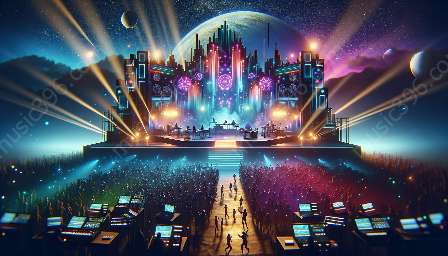Electronic music is defined by its manipulation and use of sound, and sound design plays a critical role in shaping the spatial and environmental aspects of electronic music listening experiences. Whether it's creating an immersive sense of space, evoking specific environments, or transporting listeners to otherworldly realms, sound design is a powerful tool that greatly influences how electronic music is perceived and experienced.
Understanding Sound Design in Electronic Music
Sound design in electronic music involves the intentional crafting and manipulation of sound elements, such as timbre, texture, spatialization, and dynamics. It encompasses the use of synthesizers, samplers, effects processors, and various technologies to create, modify, and shape sounds in unique and engaging ways.
Unlike traditional acoustic music, electronic music provides the freedom to construct and mold sonic landscapes that transcend the constraints of physical instruments and spaces. This freedom allows sound designers to explore and exploit the spatial and environmental dimensions of sound in ways that were previously unattainable.
Immersion and Spatialization
One of the most significant impacts of sound design in electronic music is its ability to create immersive listening experiences. Through the manipulation of spatial attributes, such as panning, depth, and reverberation, sound designers can place and move sounds within a 3D audio space, enveloping listeners in a sonic environment that transcends traditional stereo imagery.
By employing techniques like binaural recordings, ambisonics, and spatial audio processing, sound designers can transport listeners into virtual sonic landscapes, blurring the boundaries between the physical and digital realms. This immersive spatialization enhances the sense of presence and engagement, allowing listeners to feel as if they are surrounded by the music itself.
Environmental Impact and Sonic Storytelling
Sound design also influences the environmental aspects of electronic music by constructing sonic narratives that evoke specific settings, atmospheres, and moods. Whether simulating natural environments, futuristic cityscapes, or abstract soundscapes, sound designers can craft auditory experiences that transcend the boundaries of conventional reality.
Through the intentional use of field recordings, synthesis, and processing techniques, sound designers can imbue electronic music with a sense of place and atmosphere, transporting listeners to imaginary worlds and evoking emotional responses tied to these environments. This ability to create sonic environments enhances the storytelling potential of electronic music, allowing for a deeper connection between the listener and the musical narrative.
Interactivity and Spatialization
Advancements in technology have also enabled interactive spatial audio experiences in electronic music, further amplifying the impact of sound design on spatial and environmental aspects. With the rise of 3D audio platforms, virtual reality, and interactive sound installations, sound designers can create dynamic, responsive sonic environments that adapt to the movements and interactions of listeners.
Through the use of spatial audio engines, interactive controllers, and immersive playback systems, electronic music can be experienced in a more interactive and spatially dynamic manner. This interactivity blurs the lines between the listener, the music, and the environment, offering a heightened level of engagement and agency within the sonic world.
Conclusion
Sound design serves as a cornerstone of the spatial and environmental aspects of electronic music listening experiences. From creating immersive audio environments to shaping sonic narratives and enabling interactive spatialization, sound design significantly influences how listeners perceive and engage with electronic music. By harnessing the power of sound design, electronic music continues to push the boundaries of spatial and environmental experiences, offering limitless possibilities for immersive sonic exploration.


